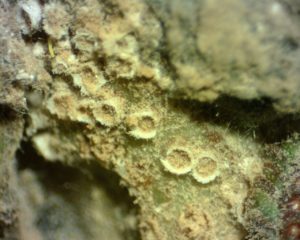Note: One thing learned from making this assignment is to ensure that the student understands which pathogen that we are requesting them to find information. Acacia Rust is an example where this common name is used but may refer to disease caused by different causal agents. The student focused on a destructive pathogen of Acacia (not in the US), while I was hoping that information would be gathered on the Acacia Rust that occurs in the US. So Dr. Appel has provided the information below for the rust that corresponds with the calendar photo. As a bonus the information about the “other” acacia rust is presented here Acacia Rust (Uromycladium tepperianum)
 COMMON NAME: Rust disease on Acacia spp.
COMMON NAME: Rust disease on Acacia spp.
SCIENTIFIC NAME: Ravenelia spp.
DISEASE DESCRIPTION
Rust diseases are caused by fungi with complicated life cycles. They cause some of the most damaging, costly diseases of agricultural crops in the world. However, this rust on native Acacia in Texas is a little known, poorly understood disease. The image depicts one of the typical spore stages of Ravenelia called aecial pustules.
This native Texas rust on Acacia should not be confused with another more destructive rust disease on similar Acacia trees that occurs in Asia, Africa and Australia. that is more destructive and would be of concern if introduced into the U.S. See Acacia Rust (Uromycladium tepperianum).
SYMPTOMS: The most obvious symptoms of the native Texas Acacia rust are growth distortions such as elongated, twisted stems. Stunted, yellow foliage may grow in the vicinity of the infections on the stems. Bud proliferation may occur at infection sites on stems producing bunches of growth called “witch’s brooms”. The fungus produces signs, in the forms of tiny pustules (called aecia) at the site of the stem infections (see image above).
BIOLOGY: Rust pathogens come in many forms. For example, some rust pathogens infect two different hosts, in a cyclical alternation from one species of plant to another on an annual basis. However, this Acacia rust does not appear to have an “alternate” host, and simply produces spores (aeciospores) that are produced in the spring and early summer to disperse and infect new Acacia spp. There are reports of a similar problem in Florida on the popular ornamentals know as Cassia trees, but no such finds have been made on the same plant in Texas.
MANAGEMENT METHODS: There are no recommended controls for this disease, in part due to the low economic value of the host and the minor impact it will have. However, the same pathogen has been reported as a disease of Cassia trees in Florida (Senna surattensis). Cassia is a popular ornamental flowering tree that is also planted in Texas. Diseased stems can be pruned and destroyed in order to manage the problem on ornamental plants.
RESOURCE LINKS*:
Caldwell, D. 2013. Fungus causing rust disease in cassia trees. Naples Daily News, January 25, 2013. http://archive.naplesnews.com/lifestyle/neapolitan/doug-caldwell-fungus-causing-rust-disease-in-cassia-trees-ep-385025635-339903551.html
Schalau, Jeff. 2015. Rust Diseases. The Backyard Gardener, September 16, 2015. University of Arizona. https://cals.arizona.edu/yavapai/anr/hort/byg/archive/rustdiseases.html
This factsheet is authored by Dr. David Appel
Factsheet information for the plant health issues represented by the images on the 2019 TPDDL calendar were written by graduate students enrolled in the Department of Plant Pathology & Microbiology PLPA601 Introductory Plant Pathology course in the 2018 Fall semester (course instructor: Dr. David Appel). This exercise provides an opportunity for a high impact learning activity where the students are tasked with producing an informational output directed to the general public and to provide opportunity for the students to write.